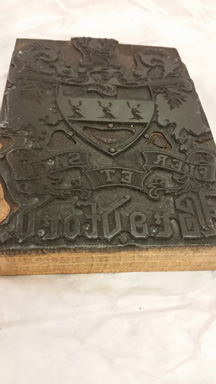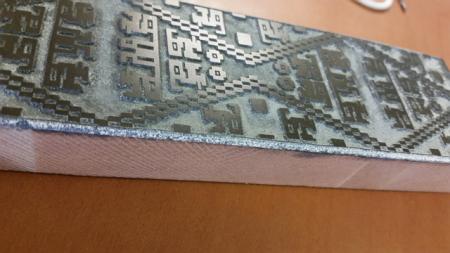Looking for information on pre-digital processes in letterpress
I’m doing a bit of research on engraving and etching processes from the late 19th century to about 1952. Specifically, I’d like to know what metal was used in these plate (see attached pics). I’m leaning toward zinc. I’m also interested in learning more about how the image was transferred to the plate and etched.
Were any metals other than copper and zinc used for sheet fed letterpress? These plates were used in small press runs.

Plate2 copy.jpg

Plate1 copy.jpg
Up until around 1880, most commercial letterpress illustrations started out as wood engravings, done mostly by hand. If it was necessary for the engravings to last longer, or if duplicates were desired (for instance so the same ad could be run in different places), there were two methods of making copies of wood engravings. One method was stereotyping, which involved making a paper mache’ mold of the engraving and then pouring stereotype metal into the mold (the metal melted at a low enough temperature so it didn’t destroy the mold). The second and higher quality process was electrotyping, where a copper duplicate of the original engraving was made by electroplating.
A big change came, probably in about 1890-1900 (not sure of the exact date). Then, for the first time, an image in the form of a photographic negative could be used as an original image which was then transferred to a metal printing plate. This was done by coating the plate with a light sensitive photographic emulsion. Then the negative was placed in intimate contact with the coated plate, and the negative/plate ‘sandwich” was exposed to light. The light would go through the clear areas of the negative and hit the photographic coating on the plate, where it would “harden” the coating.
The plate was then processed with chemicals, which dissolved away the unexposed, unhardened coating. The coating which had been “hardened” by the exposure to light, remained.
Then the plate was placed in an acid bath. Where there was no coating, the acid would etch down the bare metal plate surface. Where the coating was on the plate, the acid could not penetrate that, so the image (printing) areas would be left unchanged. This would result in a letterpress plate where the image areas are raised and the non-image areas are recessed.
Through the years since the 1900’s, various metals have been used for letterpress plates. First, there were zinc and copper. Starting in probably about the 1950’s or 1960’s, magnesium became the most common metal used. Today you can still get copper and magnesium plates (I don’t think you can get zinc any more).
One big hurdle which had to be surmounted in the acid etching processes was how to keep the acid from etching and undercutting the sides of the images. This was conquered in a few different ways (but that’s another story).
Thank you! This is very helpful.
This shows the entire process:
https://vimeo.com/134626010
Hale’s reference to the video is excellent—I just finished watching it. Things did progress somewhat from the techniques shown, such as powderless etching and then the early scanned separations that started coming in during the 1960s. But pre-digital, there was true craftsmanship and skill involved in producing photoengravings, which were first introduced in the 1880s. The Inland Printers of the 80s and 90s were a showcase of photoengraved work, as well as advertisements from the various engravers. In my time, I’ve been in a number of these shops and one of the drawbacks were the chemicals used. Unless the proof presses, like the Vandercook shown in the film, were in a separate room from the etching process, acid fumes gradually ate away at these presses, and I imagine ate away at the people working there. I used to pedal my bike to our local photoengraver in Palo Alto to pickup plates for my printing before I had a driver’s license—and they would let a kid take a peek at the back shop.
Thank you!
You can still buy from Hunter Penrose London copies of their graphic arts technicians hand book, all sorts of relevant useful stuff in there.G et one while you can.